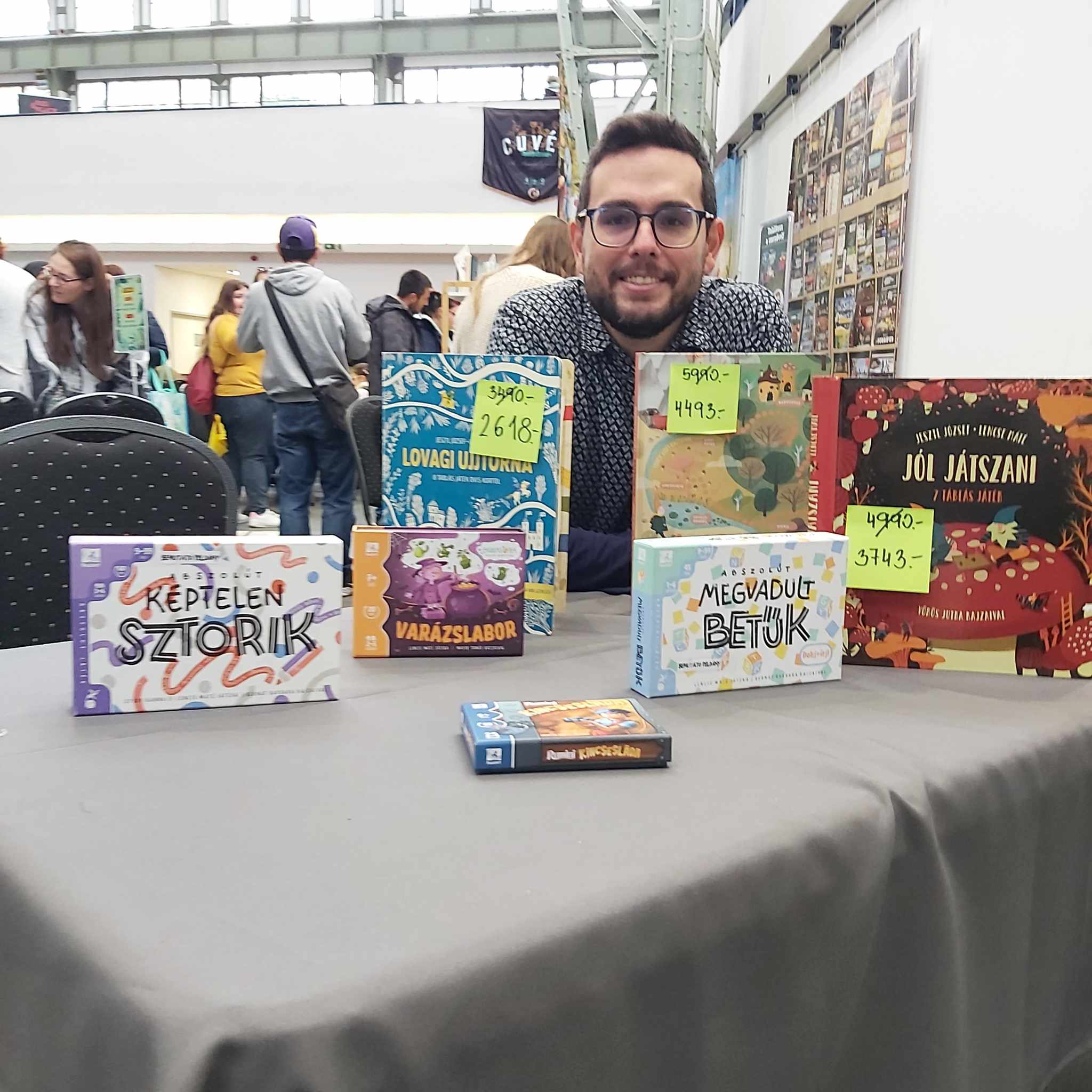The essence of play lies not in sophisticated gadgets or toys but in the creativity born from the depth of our imagination. Observe children engaged in outdoor play at a campsite, and you'd be marveled at their adept use of myriad natural adornments like wood chips, stones, sand, or mud in their games.
Equipped with accessorial game ideas, surprising sources become imaginative playgrounds. And while packaged play aids might make a for more convenient start; few elements invite intellectual growth and creativity, like unaided interplay and resourcefulness.
Let's delve into these game ideas first—the missing piece to creating delightful entertainments just within reach.
Do you like coloring?
And playing board games too? Are you interested in some games that require paper, colored pencils, and a few dice? Here you can find Máté Lencse's coloring board games for free.
Game suggestions to be played without absolutely anything
20 Questions
20 questions is a classic guessing game that encourages critical thinking and communication skills, also known as "Yes or No" game or "Guess what I'm Thinking of". It revolves around the concept of one player thinking of something and the others asking up to a limit of 20 questions to deduce what it is (it can be any amount really, or no limit).
The game begins with one player thinking of a person, place, or thing. The remaining players then take turns asking yes-or-no questions in an attempt to identify the subject within the 20-question limit. Pros of this game is that it helps create interaction and conversations between family members and if children involved it helps with the development of deductive reasoning and cognitive skills.
No special tools are needed for this game apart from a good brainstorming mindset and perhaps a means of keeping track of the number of questions asked. The game is suitably enjoyable for a wide age range but is recommended for children ages 6 and older as it may require a level of thinking that could be too complex for younger kids. Of course, everyone knows their own child best. I've played this game with younger ones myself. Age recommendations are just starting points; feel free to push them if you think it's appropriate. Overall most family settings, 20 Questions could prove to be an engaging, yet educational pastime.
Charades
Charades is a classic group game suited best for families where players use mime to describe a word or phrase without speaking, providing an entertaining and engaging way to communicate and guess. The game starts with each team taking turns where one member acts out a word or phrase without speaking while his or her team attempts to guess.
This game is great for developing creativity, mental agility, and team cooperation. Physical items required for Charades are minimal - just a stopwatch or timer for keeping track of time, and pieces of paper with prewritten words or phrases. While the game can become a source of joy for a wide range of ages, it's usually best played with school-age children, say around 6 years and up, who have a good understanding of words and phrases. Furthermore, Charades could be an effective, hands-on way to teach kids new vocabulary while also making the learning process fun and engaging.
"I'm Having a Picnic"
"I'm Having a Picnic" is a fun-filled verbal game that not only aids in memory enhancement but also bolsters alphabetical understanding. The game operates on the premise of a hypothetical picnic where each player must remember an array of picnic items corresponding to each alphabet.
For instance, player 1 starts with "I'm having a picnic and I'm bringing an apple," and player 2 continues with "...and a banana". This continues all the way through the alphabet. The advantage of this game is its aid in improving memory and vocabulary skills, while the main disadvantage could be the difficulty in keeping with the alphabetical order, especially for the tricky letters.
That said, the game has no physical tools requirement, other than a relaxed setting and the players' creativity. It is recommended for children aged 5 and above who are exploring the alphabet, but it can be fun and educational for all ages. For anyone looking to combine fun with learning at home, "I'm Having a Picnic" is an excellent choice.
Telephone
Telephone is a communication-based game that centers around the transmission of a message through a series of whispers. The commencing player begins with a short but detailed message which is then whispered to the next player. That player then passes on whatever they think they heard to the next player, and the process continues until it reaches the last player, who then shares the final message.
Often, hilarity ensues as the final message is typically a far cry from the original, demonstrating the ease with which information can be distorted in communication. And you can laugh at these giants too, which can often be quite comforting.
On the upside, Telephone is a fun game that requires no special tools, fosters social interaction, and great if you want to avoid competition as there's no real winner. With its simple format, Telephone is a game suited for families and suitable for ages above 4 years old, particularly when there's a big enough group to make the message changes more dramatic. It's a light-hearted, fun game that can foster a rich bond among family members, turning a typical family gathering into a joyful occasion.
Games playable with minimum equipment
E.g. with stones, buttons, bottlecaps.
NIM (played with pebbles 🪨🪨🪨 🪨🪨🪨)
It's out of the question that the kids haven't gathered a handful of pebbles, lurking here and there around the house. Pebbles are everything! Let's learn Nim games. You need 15 of anything (let's say pebbles) that you arrange into sets of 5, 4, 3, 2, 1 elements.

The game can be played by two people. Taking turns, you pick up pebbles, and the winner is the one who can pick up the last pebble. The only rule for picking is that you can only take from one pile in your turn, but you can take as many as you want from that pile. So, if you choose a pile with 4 pebbles, you can pick up 1, 2, 3, or 4 pebbles from it - it's up to you. However, in the same round, you cannot take from another pile! And if you have not just 15 but 16 pebbles, arrange them into four rows of four.

Now, the rule is that you can only pick up pebbles that are next to each other in a row or column (so where a gap appears, you can't pick up the pebbles at the same time), adding a new challenge to the game. If you're interested, you can find more Nim variations on the internet. It's not hard to find developmental elements in such a game; it's essentially pure mathematics. I usually recommend it to parents and educators because it has simple rules, you can play many rounds quickly, making its logic quickly discoverable. This discovery is learning itself, independent and effective learning.
Checkers, Nine Men's Morris
Buttons, pebbles, and caps make wonderful game pieces. If there are two easily distinguishable colors, a lot can be played right away. For example, checkers variations like Lahti or Vilbergen, for which you only need to draw a 2x5 or 3x4 grid and you're ready to play. Alternately, you place the pieces and then make moves. We capture like checkers - it's mandatory to capture! - and you win either by capturing all of the opponent's pieces or by having one piece left that can enter the highlighted square.
So, we capture if we can jump over the opponent's piece and there is an empty space behind it. If we can do this multiple times, we must capture more. The move is even simpler: each piece can move one square either horizontally or diagonally. I enjoy playing with these small games; it doesn't always have to be Checkers or Chess right away. These are quicker, shorter, and you can play more of them even in 10 minutes. These characteristics make these games suitable for those who don't want to deal with more complex ones - at least for now!
But for Nine Men's Morris, you also need two different pieces, which might seem suddenly boring, dusty, or old-fashioned, but click here to see what unknown paths are still waiting for you!
Tic Tac Toe
Tic Tac Toe, also known as Noughts and Crosses or Xs and Os, is a universal classic recognized for its simplicity and accessibility. It operates in a three-by-three grid and enlists two players who take turns marking the spaces in the grid with their specific symbol - often an X or an O - with the aim to align three of their marks in a row, either horizontally, vertically, or diagonally.
One of Tic Tac Toe's star advantages is its focus on simplicity, resulting in quick and engaging games; this, combined with the game's inherent strategy elements, makes it an efficient tool for brain exercise. However, once players master the strategic depth, games might commonly end in draw.
In terms of tools required, let your creativity run wild! Tic Tac Toe can be played on a piece of paper with a pen or pencil, in the sand with bottle caps or buttons, and even on cloud software, making it a versatile game option that can be brought to life anytime, anywhere.
While Tic Tac Toe can be enjoyed by all age-groups, it's particularly favored by children usually from the age of 5 and up, providing them the opportunity to experience strategic game mechanics without overbearing complexity. For any individual aiming to enrich their bonding time with children and mould those simple, playful interludes into structured learning sessions, Tic Tac Toe is certainly an engaging and bright treasury ever at the ready-inside pockets, drawn up in home-gardens or signed up in the clouds.
I really love games that don't require many tools. They show me that play is primarily a shared experience and not just a collection of objects. Experiencing this can be important not only for us but also for our children.
Of course, we also play board games. If you're curious check my article about playing games on a rainy afternoon.
Take it to the next level
Design your own family game!
Now that you get the hang of games to play without anything or just minimal tools you can also do the following. Let's gather a variety of items: colorful lids, pebbles, grab a dice, get multiple pictures or cards displaying animals, cars or fairies, use paper, pencil, eraser and then present a challenge to family members: design a brand new board game for the family!
It's up to you whether you assist them further with design, and afterwards, voila - you've acquired a new board game. My little girl has been designing games since she was four years old, certainly seeing it from me, but really, if we watch and listen ahead, we see how children transpose everything into games. So why not condense this tendency and get children involved in designing a standalone board game since we are living through a staggering rate of play needs.
No spam, ever. Unsubscribe anytime.
Spread the Fun of Learning!
Love our content? Show your support by sharing our page with your friends and help us inspire more families and educators with the joy of learning through play! Your shares truly make a difference. Thank you for being a wonderful part of our community!
